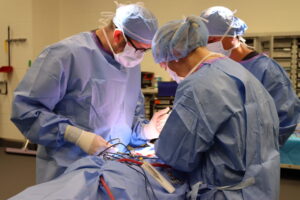Two Colorado State University research laboratories from the Translational Medicine Institute (TMI) will provide preclinical support for an up to $47 million award from the Advanced Research Projects Agency for Health (ARPA-H), a new federal research funding agency within the U.S. Department of Health and Human Services committed to advancing transformative biomedical and health breakthroughs.

Dr. Jeremiah Easley will serve as the principal investigator from the Preclinical Surgical Research Laboratory and Ben Gadomski, Ph.D. will serve as the principal investigator from the Orthopaedic Bioengineering Research Laboratory.
The project, “OMEGA: Orchestrating Multifaceted Engineering for Growing Artificial Joints,” aims to engineer, grow, and commercialize “live” replacement joints to treat osteoarthritis (OA), a degenerative joint disease affecting 32.5 million people nationwide and nearly 500 million people worldwide.
The award is part of ARPA-H’s Novel Innovations for Tissue Regeneration in Osteoarthritis (NITRO) program, which selected a total of five NITRO performer teams to create and commercialize injectable and implantable regenerative therapies to eradicate OA. It is in addition to another ARPA-H award announced in March to TMI researchers Dr. Laurie Goodrich, Dr. Kelly Santangelo, and others. By receiving two of its five awards, TMI researchers will play a significant role in addressing the biggest challenges OA patients face today.
The OMEGA team is a multi-center group led by Case Western Reserve University and includes Colorado State University, The Ohio State University, Rice University, and Washington State University. Additional partners include the Boston biotech firm Sapphiros AI Bio, University Hospitals Medical Center of Cleveland, the Louis Stokes Cleveland VA Medical Center, and Massachusetts General Hospital.
“We are honored to receive this significant ARPA-H award. It speaks to the strength of our research enterprise and our ability to innovate in ways that change lives,” said Case Western Reserve University President Eric W. Kaler in the university’s initial announcement. “Most of us know someone or have first-hand experience with degenerative joint disease. The potential treatment outcomes from this research could positively impact the quality of life for so many suffering with this disease.”
Preclinical work demonstrates value of CSU research labs
Principal investigators and leadership from the research labs at CSU’s Translational Medicine Institute have been instrumental in acquiring this award, further fulfilling the institute’s mission of improving the lives of animals and humans through biologic therapies created via the collaborative work of leading scientists and clinicians.

Over three years, the Preclinical Surgical Research Laboratory and the Orthopaedic Bioengineering Research Laboratory will provide preclinical work focused on modular total knee implants. The labs will conduct CT imaging for custom implant creation and provide project partners with the bone marrow stem cells needed to seed onto implants to regrow tissue. CSU will perform pilot studies to evaluate devices with and without cells and perform a crucial study to test the device that will ultimately replace the entire joint components through absorbable and biological materials. The third and final year will include a pivotal Good Laboratory Practice (GLP) study by CSU for FDA regulatory submission.
“This award is far-reaching and extends well beyond the confines of our laboratories or even this University,” said Easley, director of the Preclinical Surgical Research Laboratory at CSU. “It’s capable of changing lives by restoring patient mobility and alleviating the burden of joint-related disabilities worldwide. This large investment in our CSU teams has the potential to reshape the landscape of musculoskeletal healthcare, offering hope to millions and paving the way for a future where joint regeneration is not just a dream but a tangible reality.”
Joints that last a lifetime
Osteoarthritis (OA) is the third most common type of disability with an estimated economic burden of more than $136 billion per year. Due to the high cost of surgery and lack of specialty care in locations across the nation, equitable access to treatment for OA is limited. There is no cure for OA.
While it can be successful, today’s standard treatment for OA offers only temporary solutions with potential downstream consequences to patient health. Prosthetic implants used in joint replacement surgery come with risks of infection and graft rejection and last an average of 20 years before requiring revision surgeries. Patients are often limited to low-impact activities which can increase their risk of diabetes and obesity. For the nearly 800,000 OA patients managing pain with opioids, societal and financial detriments can occur.
“The mission,” explains Michael Oakes, Case Western Reserve’s senior vice president for research and a professor at the CWRU School of Medicine, “is to address the failures and limitations of current treatments by developing a safe and effective living joint that lasts a lifetime in the patient’s body.”
These load bearing “live” joints will reverse OA damage, providing lasting pain relief and longevity to restored joint function. The project aims to commercialize availability of this technology by 2029 and to meet dual goals of improved patient access and reduced health costs.
“We have an extremely exciting and rare opportunity to make a major impact on patient lives within a very short timeframe,” said Gadomski, associate research professor at CSU’s Orthopaedic Bioengineering Research Laboratory. “We are honored to be a part of this task.”